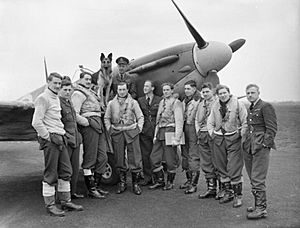George Gribble (RAF officer) facts for kids
Quick facts for kids
George Gribble
|
|
|---|---|

Pilots of 54 Squadron gathered round a Supermarine Spitfire Mk IIa in May 1941; Gribble stands at the centre, looking upwards
|
|
| Birth name | Dorian George Gribble |
| Born | 18 June 1919 Hendon, United Kingdom |
| Died | 4 June 1941 (aged 21) Off the coast of England |
| Allegiance | United Kingdom |
| Service/ |
Royal Air Force (1938–1941) |
| Rank | Flight Lieutenant |
| Unit | No. 54 Squadron |
| Battles/wars | Second World War
|
| Awards | Distinguished Flying Cross |
George Gribble (18 June 1919 – 4 June 1941) was a brave British pilot in the Royal Air Force (RAF) during the Second World War. He was known as a "flying ace" because he shot down at least six German aircraft.
Born in Hendon, England, George joined the RAF in 1938. He flew Supermarine Spitfire planes with No. 54 Squadron. He fought in the Battle of France and the famous Battle of Britain. For his courage, he received the Distinguished Flying Cross in 1940. In 1941, his plane was hit during a fight. He bailed out over the English Channel but was never found.
Contents
George Gribble: A Wartime Pilot
Early Life and Joining the RAF
Dorian George Gribble, known as George, was born on 18 June 1919. His family lived in Hendon, north London, but he grew up on the Isle of Wight. He went to Ryde School there. In March 1938, he decided to join the Royal Air Force (RAF).
His application was accepted, and he became a pilot officer. After training, he joined No. 54 Squadron in December 1938. At first, the squadron flew Gloster Gladiator planes. But in March 1939, they started using the faster and more famous Supermarine Spitfire fighter.
Flying in World War II
When the Second World War began, No. 54 Squadron mostly flew patrols. They saw little action until May 1940. That's when Germany invaded France and nearby countries. George and his squadron then flew missions over France. They helped protect the British soldiers as they retreated to Dunkirk.
On 24 May, George shot down a German Messerschmitt Bf 109 fighter near Calais. The next day, his Spitfire was damaged in a fight. He had to land his plane near Dunkirk. Luckily, he was able to get back to the United Kingdom on a ship. During Operation Dynamo, the rescue of soldiers from Dunkirk, No. 54 Squadron flew patrols to protect the ships.
The Battle of Britain
In July 1940, No. 54 Squadron became heavily involved in the Battle of Britain. This was a huge air battle over England. George flew many missions from bases like Rochford and Manston. By this time, he was a flight commander, leading other pilots. Another pilot called him the "squadron joker."
On 13 August 1940, George Gribble was awarded the Distinguished Flying Cross (DFC). This award was for his bravery and skill. The official announcement praised him for leading his flight with courage. It also noted he had destroyed three German Messerschmitt 109s.
George continued to fight bravely. On 15 August, he damaged a Junkers Ju 87 dive bomber over Dover. Later that day, he destroyed another Bf 109. He also damaged a Dornier Do 17 bomber. On 18 August, he shot down a Bf 109 and damaged other German planes.
On 24 August, he destroyed a Bf 109 near Faversham. A few days later, on 28 August, he shot down two more Bf 109s. On the last day of August, the RAF base at Hornchurch was bombed. Despite the danger, George and his wingman managed to shoot down another Bf 109.
In early September, George was promoted to flying officer. He also went to Buckingham Palace to receive his DFC from King George VI. Later that year, he damaged a Junkers Ju 88 bomber and a Heinkel He 111 bomber during other missions.
Final Missions Over the Channel
In February 1941, No. 54 Squadron moved back to Hornchurch. They now had updated Spitfire Mk IIa planes. They often flew across the English Channel to attack German targets and protect bombers.
On 4 June 1941, George was a flight lieutenant. He was leading a group of Spitfires escorting bombers. They met two German Bf 109s. As George tried to fight them, other German planes attacked him. His Spitfire's engine was damaged. He bailed out of his plane into the sea. This happened about 12 miles (19 km) from the English coast. Search teams looked for him, but he was never found. He was presumed to have died.
Legacy and Remembrance
George Gribble was the last pilot from No. 54 Squadron who had been with them before the war. He was officially credited with destroying six German aircraft. He also probably destroyed two more and damaged at least nine enemy planes.
George Gribble has no known grave. His name is remembered on the Runneymeade Memorial. This memorial honors airmen who died in the war and have no known grave. His medals, including the DFC, were sold at auction in 2007 for £35,000. They are now owned by Lord Michael Ashcroft.
See also

